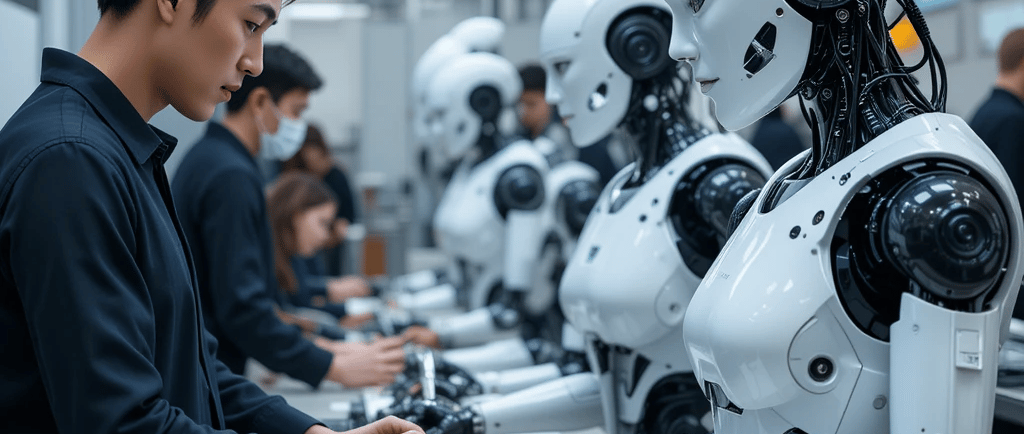Artificial Intelligence Revolution or Disruption? Unveiling the Impact of AI Automation on Jobs and the Urgent Need for Retraining
This article explores how AI automation is transforming various industries and job markets, highlighting the need for effective retraining programs to mitigate job displacement and ensure inclusive access to new opportunities
1/18/20253 min read


How AI Automation is Transforming Jobs and the Need for Retraining Programs
AI-driven automation is revolutionizing various industries and job markets worldwide. From healthcare to logistics, AI is enhancing efficiency, reducing costs, and creating new opportunities. However, this transformation also presents significant challenges, particularly in terms of job displacement and the need for retraining programs. This article explores how AI automation is changing different sectors and the importance of implementing effective retraining programs to mitigate its negative impacts.
Impact of AI Automation on Various Industries
AI automation is leaving a significant mark on several industries. In healthcare, AI improves diagnostics, accelerates drug discovery, and facilitates personalized medicine, enhancing patient outcomes and optimizing operations. In finance, AI is used for fraud detection, algorithmic trading, and customer service automation, making financial operations more secure and efficient.
Retail and e-commerce also benefit from AI, which enables personalized recommendations, dynamic pricing, and optimized inventory management. In transportation and logistics, AI is transforming the industry with autonomous vehicles, route optimization, and warehouse automation, improving safety and sustainability.
However, this automation also carries the risk of job displacement. In manufacturing, robotics and automation are replacing low-skilled jobs in tasks such as assembly and quality control. In retail, cashiers and stock clerks are being displaced by automated inventory systems and checkout technologies. In transportation and logistics, drivers and couriers are at risk due to autonomous vehicles and drones. In customer service, chatbots and virtual assistants are reducing the need for human support representatives.
Job Displacement and Retraining Programs
The advancement of AI and automation is putting millions of jobs at risk in the coming years. According to a Goldman Sachs report, around 300 million jobs could be affected by generative AI, meaning that 18% of global work could be automated. This impact will be more pronounced in advanced economies than in emerging markets.
To mitigate these effects, it is crucial to implement national retraining programs. The U.S. Department of Labor has emphasized the importance of designing and deploying AI in ways that maximize its benefits while minimizing risks to workers' well-being. Initiatives like the GSA's AI training series and the Job Opportunity Fund are aimed at equipping workers with the skills needed to adapt to the new technological era.
Inclusive Retraining Programs
Retraining programs must be inclusive to address disparities in access to technical education and infrastructure, especially in underserved communities. IBM, for instance, has committed to training two million people in AI by 2026, with a focus on underrepresented communities. These initiatives are crucial for bridging the skills gap and ensuring that everyone can benefit from the opportunities created by AI.
Collaboration between Policymakers and Industries
Collaboration between policymakers and industries is essential to address the challenges posed by AI automation. Comprehensive frameworks must be established to ensure equitable access to retraining programs. Unions also play a crucial role in providing workers with the tools and guidance needed to navigate the changing job landscape.
Mental Health Support in Retraining Programs
The psychological impact of AI automation on workers cannot be underestimated. Employees who fear losing their competencies and autonomy to AI are more likely to perceive it as a threat to their identity, which can lead to anxiety and depression. Retraining programs must include mental health support to help displaced workers manage the psychological impacts of job loss.
Job Displacement Statistics and Trends
Statistics show that job losses due to AI are on the rise. In May 2023, AI contributed to nearly 4,000 job losses in the U.S., and it is projected that AI could make 375 million jobs obsolete in the next decade. These trends underscore the urgent need for retraining and reskilling programs to mitigate the negative effects on employment.
Effective Strategies for Designing Retraining Programs
To design effective retraining programs, companies should invest in workforce development, align programs with job market demands, and provide continuous support and resources. Integrating technology into retraining efforts, such as using generative AI tools for training, can significantly improve outcomes.
Conclusion
AI automation is rapidly transforming various industries and job markets. While it offers numerous opportunities to enhance efficiency and create new jobs, it also presents significant challenges in terms of job displacement. Implementing inclusive and effective retraining programs is crucial to mitigate these negative impacts and ensure that everyone can benefit from the opportunities created by AI. Collaboration between policymakers, industries, and unions, along with mental health support, will be essential for successfully navigating this technological transition.
If you want to read the text of the complete research that led to this article, write to our email.
